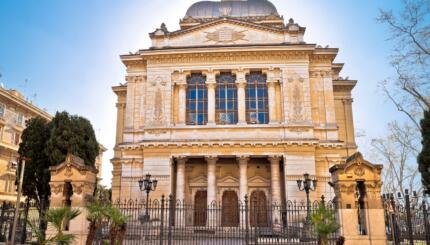As a Jew with North African roots, I have always felt that my culture’s rich and diverse traditions set me apart from my peers and classmates. On , I have always felt grateful that rice and hummus found their way into every meal and felt sympathy for my friends who tried to feel satiated on potatoes. tables included hitting one another with leeks or green onions and rotating a plate of matza around someone’s head while singing “Ha Lachma Anya.” While most of my classmates celebrated Rosh HaShanah with only apples and honey, Mizrahi Jews also celebrate the New Year with dates, beets, and fish’s or lamb’s head. However, on Hannukah, there was nothing that separated me from my Ashkenazi friends. My mom fried latkes, we stuffed ourselves with jelly-filled donuts, played with dreidels and lit the Hannukiah. Much to my dismay, the only thing that set me apart from my peers was that I didn’t receive eight nights of gifts. According to my mom, “that isn’t our custom.”
When I moved to Israel after college, I intentionally sought out as much information as I could about my Mizrahi heritage. Yet, even in Israel, it felt like Middle Eastern and North African Jews preferred to celebrate Hannukah with only the customs that were consistent across the country, rather than those they brought with them from their communities. During my first year in Israel, I wasn’t able to learn more than a few songs about Hannukah and that some North African Jews preferred calling sufganyot “spanj”.
It wasn’t until I immersed myself in the writings of Sephardic rabbis at a Sephardic Beit
in Jerusalem called
Mimizrach Shemesh
, that I was exposed to the rich Hannukah tradition of Jews from North Africa and the Middle East. For example, it was customary for Yemenite Jewish women to wear clothing decorated with bells and hold bells in their hand. After the lighting of the candles, they would go out into the street and play music using the bells to celebrate the miracle of Hannukah. In Turkey, it was customary to eat dairy products in memory of the miracle that happened when Judith tempted Holofernes with cheese and wine. In Libya mothers sent their married daughters spanj (Libyan Doughnuts) and families bring the elders of the synagogue and the children in Jewish schools spanj. In Tunisia the Hannukiah would hang in the entrance of the home from the time of Hannukah until Purim.
Moreover, the Mizrachi rabbinic literature suggests a way to think about not only the rituals of the holiday but the way in which we should be focusing our celebrations. In the early 20th century, Moroccan Rabbi Yosef Messas received a letter from a Jew who had become skeptical of the Hannukah oil miracle story because he couldn’t find a written source that attested to its authenticity. In his response, Messas strongly rejected the idea that a written source was the only way to prove something as authoritative and accurate. Messas argued that the home, and specifically the teachings of the parents, were of equal importance to the written Rabbinic laws. He wrote that the “love and care that parents build with their children” creates a source of authority. Parents, he wrote, “teach stories to their offspring that pass on from generation to generation,” and these stories are on equal standing with written traditions. In this response, Messas highlights the authority and importance of parents in passing on Hannukah traditions and locates the home as the center of authority in this holiday.
Rabbi Haim David Halevi a 20th century Sephardic rabbi who served as the chief Rabbi of Tel Aviv argued that it was more important for all family members to be present during the lighting of the Hannukiah than for the Hannukiah to be lit in a timely manner. He wrote that such a lighting in the home is the “miracle of our time.”
It seems to me that Hannukah has lost the variety of traditions that characterize other Jewish holidays like Pesach or Rosh HaShanah. We should no longer exclusively rely on our schools and synagogues to preserve the diversity of our Jewish traditions. Rather, the home should be the place where all the varied ways of celebration are passed on and preserved and the traditions will continue to be the way we preserve the home.
This teaching is based on what I studied at Mizrach Shemesh a Beit Midrash and center for social activism in Jerusalem. For more visit mizrach.org.il



